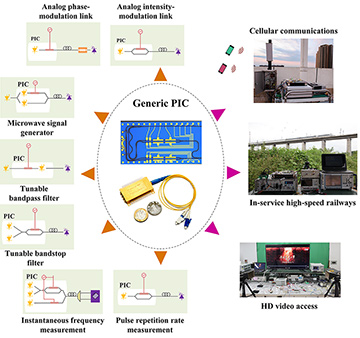 Generic photonic integrated circuit (PIC) and applications, including seven fundamental microwave photonic functions. Demonstrated daily-life applications have involved electromagnetic interference detection for Chengdu–Chongqing High-Speed Railway (southwest China), broadband cellular communications and remote HD video access. [Enlarge figure]
Generic photonic integrated circuit (PIC) and applications, including seven fundamental microwave photonic functions. Demonstrated daily-life applications have involved electromagnetic interference detection for Chengdu–Chongqing High-Speed Railway (southwest China), broadband cellular communications and remote HD video access. [Enlarge figure]
Wireless communication traffic is growing at a staggering rate, and electronic techniques face increasing difficulties in handling this growth. Microwave photonics (MWP), which transfers wireless signal processing and transmission challenges from the electronic to the photonic domain, could provide a wealth of new opportunities to address this issue, due to the inherently broadband and low-loss features of photonics. Moreover, photonic integrated circuits (PICs) have promoted MWP to new heights,1 to overcome the saturation of Moore’s law in electronics and satisfy the traffic growth given by Gilder’s law.
Integrated MWP thus can represent a compact, reliable and environmentally attractive alternative for keeping up with exponential traffic growth, and empowers key microwave/wireless functionalities. However, state-of-art integrated MWP circuits have heretofore had limited functionality, and most of that has been conceptually or functionally demonstrated in laboratory tests within well-conditioned environments or under offline conditions.
This has left a major last gap between the laboratory and real-world applications, as these circuits will need to be massively deployed in outdoor scenarios and remotely distributed in harsh environments. Recently, our group has reached a significant milestone in bridging that gap, and transferring the integrated-MWP concept from the laboratory to daily life.2
At the core of this advance is a multifunctional integrated photonic chip that we have proposed and fabricated for general-purpose microwave photonics. The chip, fabricated on InP platform, monolithically integrates tunable lasers, modulators, couplers, and reconfigurable architectures and signal-flows. Thus, diverse functions across the microwave signal generation, transmission and processing domains have been enabled, including a remote signal generator, analog intensity-modulation and phase-modulation MWP links, tunable bandpass and bandstop filters, microwave frequency measurement and pulse-repetition-rate measurement.
More important, the generic microwave photonic chip is stable and robust for direct deployment in real-world applications. It has been directly deployed for detecting electromagnetic interference (EMI) along in-service high-speed railways in southwest China, as well as for cellular communications and remote HD video access.2
We believe that this work can be considered the first paradigm for real-time, daily-life applications of integrated MWP in outdoor scenarios, and a key step toward massive daily-life deployments. As such, it could bring comprehensive benefits to many aspects of society, much as integrated electronic circuits have done.
Researchers
X. Zou, F. Zou, B. Lu, X. Yan, G. Yu, B. Luo, L. Yan and W. Pan, Southwest Jiaotong University, Chengdu, China
Z. Cao, X. Deng and A.M.J. Koonen, Eindhoven University of Technology, Eindhoven, Netherlands
J. Yao, University of Ottawa, Ontario, Canada
References
1. D. Marpaung et al. Nat. Photon. 13, 80 (2019)
2. X. Zou et al. Laser Photon. Rev. 13, 1800240 (2019).
